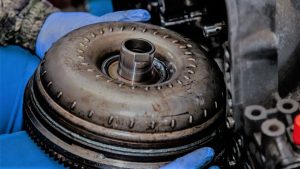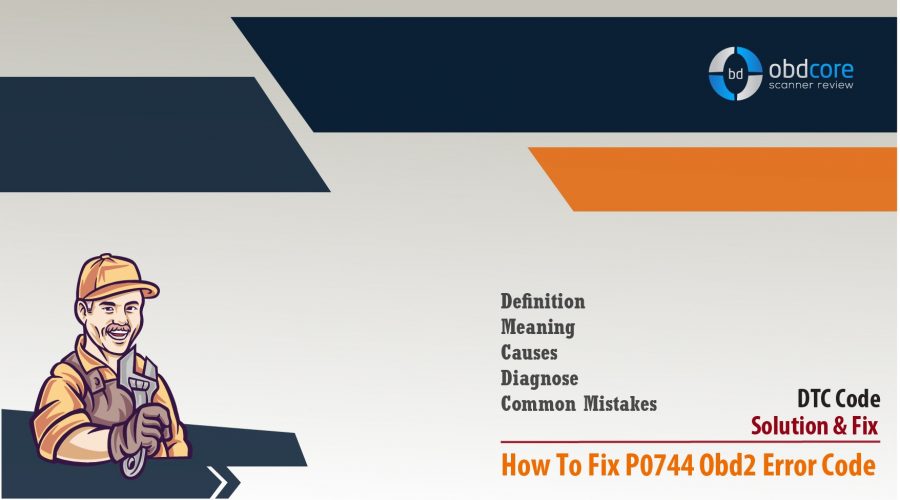If you are driving and suddenly see the Check Engine light turn on, it’s important to know what that means. One common error code is P0744. This article will explain what P0744 is, how to diagnose it, and how to fix it. Stay safe on the road and keep your car running smoothly by following these steps!
What is the P0744 OBD-II Error Code?

The P0744 OBD-II code indicates that there is a problem with the torque converter clutch circuit. This can occur when there are issues in either of two areas: the electrical portion of the mechanical part. How do you know if your car has this error? The Check Engine light will illuminate on your dashboard to alert drivers about problems with their vehicles.
OBD-II Code P0744: Symptoms, Causes & Fix
Is P0744 a Diagnostic Trouble Code?
The P0744 is not considered a diagnostic trouble code or DTC. It’s important to understand what these designations mean in order to properly diagnose your vehicle when necessary. There are four types of OBD-II codes: generic powertrain codes (P0xxx), manufacturer-specific codes (P1000) through P1999, and C1249, which are generic chassis/body codes for both manufacturers; lastly, there are standard OBD-II DTCs as well.
What are the causes of the P0744 OBD 2 Code?
There are a few potential causes of the P0744 OBD code. These can include problems with:
- The input/output (I/O) speed sensor
- The transmission fluid temperature sensor
- The solenoid pack assembly
- The torque converter clutch actuator and the torque converter clutch wiring.
- The circuit wiring between these components and the PCM (powertrain control module) is damaged.
- The resistance of the torque converter clutch solenoid is not within the manufacturer’s guidelines.
- If a fault is diagnosed in Powertrain Control Module (PCM) or Transmission Control Module (TCM), it can also generate a P0744 error code.
Signs your car has a P0744 Error:
Some common symptoms of having a P0744 error without scanning your car’s computer are:
- You may notice that your vehicle hesitates or stalls when you try to accelerate.
- This could also happen while driving at slow speeds, such as in traffic jams.
- You may also hear a whining noise when the car is in gear.
How to determine the P0744 OBD code?
To properly diagnose your vehicle, you’ll need to use an OBD-II scanner. Once plugged into your car’s computer, it will read any error codes that are stored and provide information on what might be causing them.
How does a mechanic diagnose the P0744 code?
The diagnostic process for the P0744 is completed by examining transmission fluid levels in an OBD-II vehicle. The most commonly used reason behind these codes is that sand impedes fluids in the transmission valves. The mechanic will need to change contaminated transmission fluids. After the transmission fluids are thoroughly inspected and replaced, it should be removed and inspected again to confirm the system’s operation.
Can an issue in Transmission Control Module, Torque converter clutch, torque converter clutch solenoid, and torque converter clutch circuit cause P0744?
The P0744 is an error code for a problem with the transmission control module, torque converter clutch, torque converter clutch solenoid, or circuit. If a fault is diagnosed in Powertrain Control Module (PCM) or Transmission Control Module (TCM), it can also generate a P0744 error code.
How do I fix code P0744?

There is no one-size-fits-all answer to this question, as the causes and solutions for the P0744 OBD code can vary greatly. However, some potential fixes could include:
- Replacing or repairing the solenoid pack assembly
- Cleaning the torque converter and the torque converter clutch wiring
- Replacing the transmission fluid temperature sensor
- Checking and repairing the electrical wiring between components
- Completely draining the dirty transmission fluid. Cleaning the dirty transmission fluid tray and filling it with clean transmission fluid. Dirty fluids cannot only cause transmission overheating but also transmission slippage. Transmission overheating could damage the mechanical parts.
- Ensuring that transmission hydraulic lines are clean and that the transmission valve, transmission valve body, and hydraulic lines are all properly sealed and that they can maintain proper pressure.
If you are experiencing any of the symptoms mentioned above, it’s important to take your car in for a diagnosis as soon as possible. The causes of the P0744 OBD code can be difficult to track down and may require the expertise of a mechanic. However, some fixes can be done DIY-style, such as cleaning the torque converter or replacing a sensor. Always consult your car’s owner’s manual before starting any repairs.
How to avoid getting the P0744 OBD-II code altogether?
One way to help prevent the P0744 error code is to ensure that your car is properly maintained. This includes keeping up with regular oil changes and using the correct weight and type of transmission fluid. Additionally, drivers should be on the lookout for symptoms that might indicate a problem with their vehicles before it becomes too costly or difficult to fix.
Always visually inspect your car from top to bottom to its undercarriage. Keep an eye on roadside excessive debris that could damage pipes or cause potential wiring issues. Notice any burnt smell in the engine bay and find out what is causing it? Although you can make simple repairs at home, do not make a complex repair attempt at home.
If possible, do not make a habit of overlooking malfunctions. If you have made any repair attempts, do not do further repairs yourself; take your vehicle to an authorized mechanic.
Common mistakes when diagnosing the P0744 code
These are the most common mistakes when diagnosing the P0744 code
- Overlooking the possibility of a failed transmission fluid temperature sensor.
- Replacing the solenoid pack when it isn’t necessary because there is no scan tool available to test for continuity in individual circuits within the wiring harness between components.
- Not replacing contaminated transmission fluids with fresh ones, may lead to further problems down the line!
- Ignoring any symptoms before they get worse because of possible costs associated with diagnostics and repairs.


